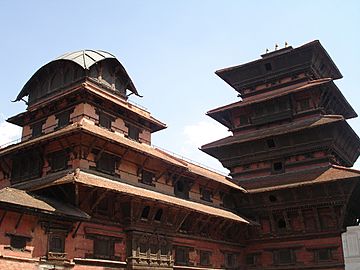Kathmandu Valley facts for kids
| UNESCO World Heritage Site | |
|---|---|

Kathmandu valley seen from Palanse, Bhaktapur
|
|
| Location | Province No. 3, Nepal |
| Inscription | 1979 (3rd Session) |
| Extensions | 2006 |
| Endangered | 2003–2007 |
| Area | 167.37 ha (413.6 acres) |
| Buffer zone | 70.29 ha (173.7 acres) |
The Kathmandu Valley (Nepali: काठमाडौं उपत्यका, Nepal Bhasa: स्वनिगः, नेपाः गाः) is a very special place in Nepal. It was once known as the Nepal Valley. This valley is like a meeting point for old civilizations from South Asia and other parts of Asia.
It has more than 130 important monuments and buildings. Many of these are holy places for people who follow Hinduism and Buddhism. Seven of these amazing sites are even recognized as World Heritage Sites by UNESCO.
Contents
History of the Kathmandu Valley
Historically, the Kathmandu Valley and the areas around it formed a group of kingdoms called the Nepal Mandala. Until the 1400s, a city named Khwopa was the main capital.
Later, two more capital cities were created: Kathmandu and Yala. After the Gorkha Kingdom took over the valley, it became the capital of their growing empire. This is how the name "Nepal" started to be used for all the lands they had conquered.
World Heritage Sites in the Valley
The Kathmandu Valley is home to seven World Heritage Sites. These are places that are very important to the world's history and culture. They are protected because of their unique value.
These sites include ancient palaces, temples, and stupas. They show off the amazing art and architecture of the people who lived here long ago.
Related pages
Images for kids
-
Pashupatinath Temple, dedicated to Pashupati.
See also
 In Spanish: Valle de Katmandú para niños
In Spanish: Valle de Katmandú para niños








